Learn how these parameters of the Energy Settings dialog help to define the energy analytical model, and understand their impact on its accuracy and processing time.
When preparing to perform an energy analysis, you define parameters in the Energy Settings dialog. The Analytical Space Resolution parameter and the Analytical Surface Resolution parameter provide important information used by the algorithm that generates the energy analytical model.
To open the Energy Settings dialog, click Analyze tab Energy Analysis panel
Energy Analysis panel Energy Settings.
Energy Settings.
These parameters apply to energy analysis performed using any analysis mode: Use Building Elements, Use Conceptual Masses, or Use Conceptual Masses and Building Elements.
The default values for the Analytical Space Resolution parameter and the Analytical Surface Resolution parameter have been determined to provide an optimum balance between energy model accuracy and processing time for most Revit models. However, because Revit model size, complexity and quality can vary widely, it can sometimes be beneficial to modify these parameters in order to provide greater accuracy and/or to reduce processing time of the energy model.
Analytical Space Resolution
This is the primary parameter that influences the energy model's accuracy and processing time. It defines the minimum gap distance between Revit elements that will be ignored in the identification of energy model spaces.
For the Analytical Space Resolution parameter:
- Default value = 18 inches (457.2 mm)
- Minimum value = 6 inches (152.4 mm)
- Maximum value = 10 feet (3048 mm)
The maximum distance between Revit elements that may be ignored in the identification of energy model spaces is 2 times the Analytical Space Resolution setting.
This concept can be illustrated as follows:

Plan view of 2 walls bounding an interior space with a gap between them of dimension X
If Analytical Space Resolution = 18 inches (457.2 mm), then:
- If X < 18", then the gap will be ignored and the energy model space will be created.
- If X > 18"' and < 36" (914.4 mm), then the gap may or may not be ignored.
- If X > 36", then the gap will not be ignored and the energy model space will not be created.
Analytical Surface Resolution
This parameter drives the ability of the algorithm to find individual analytical surfaces. It should be less than the smallest dimension of any surface you wish to be included in the energy model.
For the Analytical Surface Resolution parameter:
- Default value = 12 inches (304.8 mm)
- Minimum value = 3 inches (76.2 mm)
- Maximum value = 10 feet (3048 mm)
This concept can be illustrated as follows:

Plan view of a wall with a section of dimension
If Analytical Surface Resolution = 12 inches (304.8 mm), then:
- If X < 12", then an energy model surface for this section of wall will not be created.
- If X > 12" and < 24" (609.6 mm), then an energy model surface for this section of the wall may or may not be created.
- If X > 24", then an energy model surface for this section of wall will be created.
Balancing Accuracy with Processing Time
When you reduce the values for Analytical Space Resolution and Analytical Surface Resolution, the processing time required to create the energy model increases significantly.
When you increase the values of these parameters, the processing time required to create the energy model is significantly reduced.
Reducing these values does not necessarily result in a more accurate energy model. For example, a lower Analytical Space Resolution value can result in smaller gaps that exist between Revit elements, leading to the omission of some spaces from the energy model. Experiment with different values in different models to understand how these parameters work.